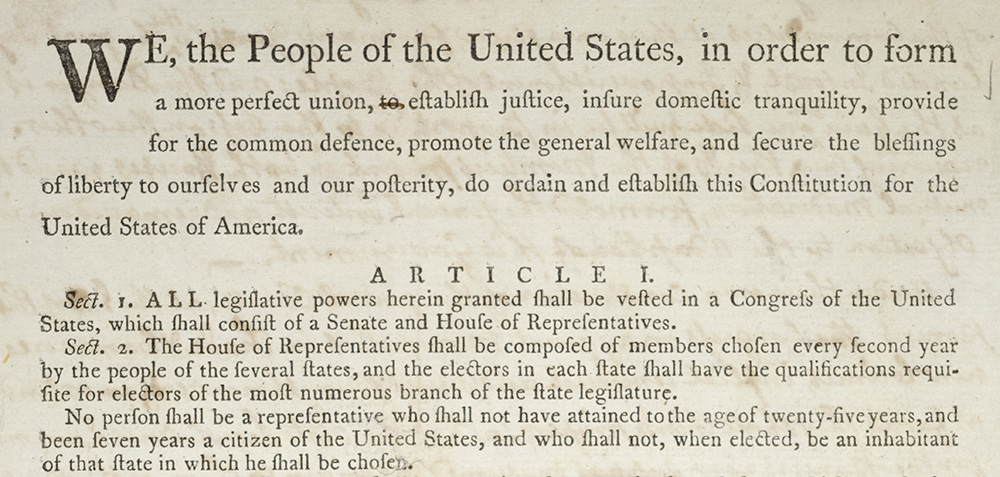Constitution Conserved
 When the Chapin Library’s draft printing of the U.S. Constitution was lent to the Sterling and Francine Clark Art Institute in 2014, to be displayed next to the Lincoln Cathedral copy of the Magna Charta, conservators expressed concern over a “fog” within our document’s protective frame of glass and Lexan polycarbonate. Their initial fear was that mold had formed, which might affect the four leaves of the document. Later, it was thought that the Lexan portion of the “sandwich” in which the document was contained had deteriorated due to age. We returned the Constitution to the “shrine” of the Founding Documents of the United States in the Chapin Gallery and spent some months considering the problem.
When the Chapin Library’s draft printing of the U.S. Constitution was lent to the Sterling and Francine Clark Art Institute in 2014, to be displayed next to the Lincoln Cathedral copy of the Magna Charta, conservators expressed concern over a “fog” within our document’s protective frame of glass and Lexan polycarbonate. Their initial fear was that mold had formed, which might affect the four leaves of the document. Later, it was thought that the Lexan portion of the “sandwich” in which the document was contained had deteriorated due to age. We returned the Constitution to the “shrine” of the Founding Documents of the United States in the Chapin Gallery and spent some months considering the problem.
Finally this spring, we arranged to have the Constitution moved in its heavy frame to our conservation room on-site, there to be examined by staff from the Williamstown Art Conservation Center, led by Rebecca Johnston. We had already examined the document within its frame, and the construction of the frame itself, as far as this could be done externally and through archival records, and had discussed possibilities for re-mounting for greater stability and longevity.
On dismantling the frame, the Constitution was found to be unharmed, and the Lexan unblemished. The “fog” we had seen was simply a film on the inside of the external plate glass “skin”, possibly caused by infiltration of water vapor since the Founding Documents case was built in the 1980s. Conservators carefully removed the document from the thin piece of Lexan to which it had been affixed, and gently humidified and pressed it. High-resolution photographs were taken, using the reprographic camera recently acquired by the Chapin Library and College Archives from Digital Transitions. Finally, the four leaves of the Constitution were invisibly mounted between sheets of Optium museum-grade acrylic, and the ends of the sheets were carefully sealed. This new “sandwich” was put into the existing frame with the original plate glass panels and one of the Lexan panels, and the whole returned to the “shrine”. All moving and associated tasks were performed by staff from the Facilities Department of Williams College.
The beautifully clear result may be seen, with the other founding documents, in the Chapin Gallery (Sawyer Library 406), Monday through Friday from 10:00 a.m. to 5:00 p.m.
The Declaration of Independence, which is framed similarly with glass and Lexan, has not developed the same issues. – WGH
Shown is a detail from the first printed leaf of the second draft printing of the U.S. Constitution, from the Constitutional Convention in Philadelphia in 1787, formerly owned by George Mason of Virginia.